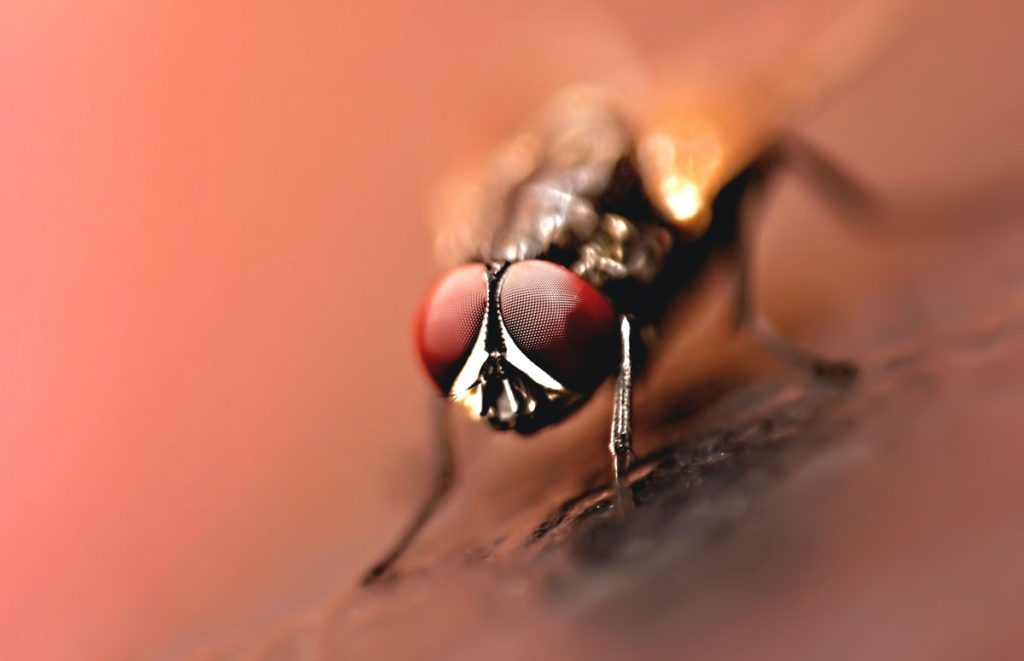Have you ever wondered why it is so hard to catch a fly? Perhaps you have used a fly swatter in the summertime? Flies see motion, color, shapes, and light very differently from humans. That’s why they can react so quickly to the slightest form or movement.
Do Flies Have 1000 Eyes?
Flies have 2 large compound eyes on their head, and both of them are made up of 4,000 to 4,500 lenses which could kind of be considered the equivalent of having thousands of eyes! These special lenses create a large number of small pictures that allow the fly to see movement from the right, left, front, and above their little head. 28,000 light-sensitive structures called ommatidia (pronounced: om-ha-tee-dee-ya) are grouped under the cornea of the fly’s eyes.
Compound Eyes
Like those of a fly, compound eyes are only found in invertebrates. They are very intricate in their functionality, allowing insects like the common housefly to see fast-moving objects like a fly swat! When the ommatidium collects light, it is filtered through the lenses, followed by a crystalline cone structure, pigment cells, and visual cells. Every individual ommatidium has a nerve thread connected to the optic nerve, which transmits information to the fly’s brain, creating almost a 360-degree picture.
As impressive as this all sounds, compound eyes do have their downsides. Flies can’t focus and are short sited. Unlike a human eye, a compound eye is restricted by the lack of a pupil and an inability to move. Without pupils, the fly can’t control the amount of light entering the lens, making focusing impossible.
New Study: How Fruit Flies Use Eye movements to Coordinate Their Wings
Mechanical engineering researchers at Penn State College of Engineering looked into how fruit flies use their vision to improve flight control. Jean-Michel Mongeau, director of the Bio-Motion Systems Lab, stated:
“My lab is interested in active sensing, which is a branch of engineering and biology that studies how sensor movement, like eyes scanning a room, can enhance sensing itself.”

The research team wanted to focus on the visual aspects associated with the fly’s wing movement instead of focusing on the wing movement itself, as so many other studies have done.
“We’ve shown that their eyes can control and stabilize their vision better than we originally thought by reducing motion blur,” explained Benjamin Cellini, a doctoral student studying mechanical engineering and the first author of the paper.
Benjamin explained the reduction of blur that is achieved in the fly’s vision is an important factor:
“Like in sports, they teach baseball players to follow the ball with their eyes to reduce blur and increase batting performance.”
Mongeau pointing out that one of the vital discoveries to come out of this study was the fly’s ability to slow down visual motion:
“An important principle we discovered here was that fly eyes slow down visual motion that go into the brain, and this process enhances their flying behavior,”
If you are interested in learning more about compound eyes, you can watch this explainer video by Larry Keeley, which describes what it is like for animals with compound eyes visually:
The Most Annoying Flies Are Probably Male
Fun Fact: When you are being irritated by a fly buzzing around, it is important to note that it is likely to be male.
Female flies generally mind their own business with not much care for anything but food. Male flies can be real pests due to a unique area found in a specific part of their compound eyes affectionately named by scientists as „The Love Spot.” Eeeeew
Basically, male flies only have eyes for female flies, and to catch a fly, you need to be able to spot a fast-moving object. Evolution has provided the male fly with this secret weapon, „The Love Spot,” said to enhance their ability to process visual signals by 60%.
In Conclusion
How many eyes does a fly have? The answer is two. However, those two eyes are made up of thousands of little cameras taking pictures that create one big image. Pretty cool, huh? What is even cooler is that scientists and engineers are now studying flies to improve robotic technologies.

Lydia King is a huge animal lover and has always been fascinated with learning about the animal kingdom. She enjoys writing about anything animal related from scientific information about rare species to animal references in pop culture.












